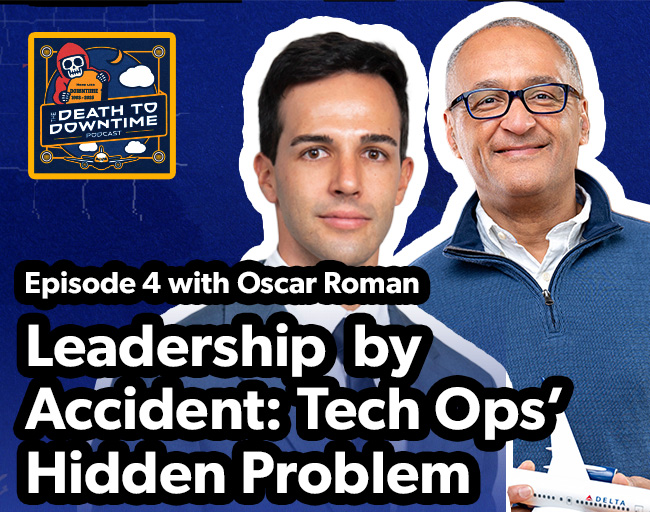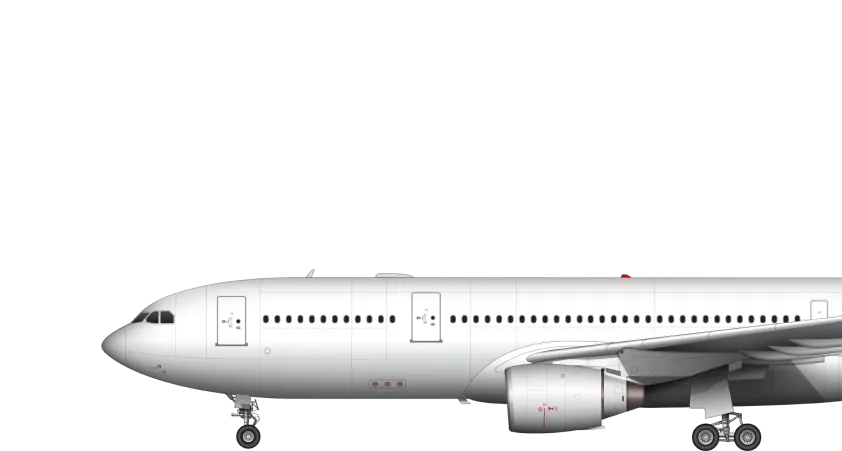Episode 4: Discussing Leadership by Accident and Other Aviation Tech Ops Challenges
Airlines spend millions fighting downtime, but what if the real bottleneck isn’t technical—it’s leadership? In this episode of The Death to Downtime Podcast, host Andy Hakes sits down with Oscar Roman, VP of Maintenance Ops at Saudia, to uncover aviation’s hidden leadership crisis. ✈️ How COVID permanently changed aviation strategy ⚙️ Why technical and commercial teams can’t afford to stay siloed 👨🔧 The dangers of “leadership by accident” 💡 Why airlines need two career paths: technical mastery & leadership 🚨 The true cost of bad leadership on culture, safety, and revenue 🤖 Can regulators and AI close the leadership gap? Whether you’re on the hangar floor or in the boardroom, this episode will challenge how you think about leadership in aviation.

Airline Tech Ops Leadership: How to End “Leadership by Accident” and Cut Downtime
In aviation, downtime isn’t just costly — it’s existential. When planes aren’t in the air, they aren’t making money. But here’s the uncomfortable truth: the biggest threat to uptime isn’t always mechanical. It’s leadership.
That was the recurring theme in my conversation with Oscar Roman, Vice President of Maintenance Operations at Saudia, on The Death to Downtime Podcast. What unfolded wasn’t your typical management platitude session. Instead, it was a candid exploration of what happens when airlines treat leadership as an afterthought — and how to design it as rigorously as any maintenance manual.
Why Airline Tech Ops Leadership Deserves Attention
Oscar framed it early: aviation is full of brilliant technical experts who one day find themselves handed a leadership role. Sometimes that transition is intentional. Too often, it’s accidental.
“The transition to be a leader… is not necessarily easy. And the skills that you need as a leader are not the ones that you need as a subject matter expert.”
Think about it: a technician who’s mastered the inner workings of a 777 flap actuator might suddenly be managing people. There’s no manual for that. No checklist. No torque settings. Just a vague job title and expectations to “lead.”
And that, Oscar argued, is the silent crisis in airline tech ops leadership.
The Post-Pandemic Shakeup: More Than Just Cost Cutting
COVID reshaped the industry in visible and invisible ways. Yes, airlines slashed costs and restructured. But Oscar sees the next phase as a reinvention — not just of models, but of mindsets.
“We are moving towards a new phase… reinventing aviation and… the commercial models.”
Supply chain headaches, geopolitical instability, and economic uncertainty remain. But he noted something else: the “third disruption.”
The first was the low-cost carrier revolution. The second, aircraft leasing. The third? The intersection of digital, data, and AI, not just in operations but in commercial strategy.
And yet, Oscar warned, the “hardware” of aviation — planes, parts, processes — is only half the system. The “software” — people, leadership, culture — is often neglected.
“All of this is hardware, but we cannot forget about software… leadership, people, culture… is the system that holds all together.”
Why Tech Ops Leaders Must Understand Revenue
A theme we circled back to often was the divide between technical and commercial teams. Oscar has seen it everywhere: maintenance folks who think the airline exists to keep airplanes perfect; revenue folks who think maintenance is a necessary evil.
Bridging that gap isn’t optional.
“Why we are maintaining airplanes… it’s so we can operate and we can, generate revenue.”
Leaders who don’t connect those dots leave their teams siloed — wrench-turners who don’t see how their work impacts ticket sales, loyalty programs, and the P&L. And silos in aviation don’t just hurt culture. They cost millions in preventable downtime.
The Hidden Crisis: Leadership by Accident
We’re good at measuring technical gaps. The “technician shortage” gets headlines because it’s visible and countable. But leadership? That’s fuzzier — and therefore too often ignored.
Oscar put it bluntly:
“We are leaving leadership to a chance and not making it structural.”
Think of the difference. A flap actuator replacement comes with a 300-step procedure. Leadership promotions? Hand someone a title, wish them luck, and cross your fingers.
No wonder people flounder.
The Seniority Trap
I shared a story about a small shop I worked in years ago. The director of maintenance left. The only person who knew certain aircraft inside and out was promoted. Overnight, he was expected to manage people, schedules, and budgets. Unsurprisingly, he struggled.
That wasn’t a one-off. It’s systemic. Promotions based on seniority or technical prowess, with no design behind them, produce leaders set up to fail.
And when they fail, it’s not just their career at stake. It’s the airline’s uptime, safety culture, and financial stability.
Two Career Paths: The Fix Airlines Desperately Need
Oscar’s prescription? Stop forcing square pegs into round holes. Instead, design two clear career ladders:
- Technical Mastery — for SMEs who want to keep solving complex engineering problems.
- Leadership — for those who want to coach, mentor, and shape culture.
“We might need… two career pathways… Why… don’t we reward the technical expertise as much?”
Other industries do this well. Software developers can rise to the level of “distinguished engineer” without managing a soul. Why can’t airlines reward their top AMEs or planners the same way?
The Real Cost of Leadership by Accident
Leadership gaps are harder to measure than technician shortages. But they’re more dangerous.
Unprepared leaders default to doing instead of delegating. They become bottlenecks. Teams burn out. Safety margins erode.
“I am a good ‘doer’… promoted… my natural behavior will be to continue doing… I am now becoming the bottleneck.”
Oscar compared it to soccer: imagine the most talented player hogging the ball. The team doesn’t win, no matter how good he is.
The cost? Burnout, disengagement, delayed escalations, and lost ownership. Or in aviation terms: downtime, inefficiency, and potentially compromised safety.
Stop Bailing the Boat. Fix the Hole.
Here’s where leadership design becomes survival. Too many leaders are so consumed by firefighting they never address root causes. Oscar used the perfect metaphor:
“We are in a boat. There is a hole… If you are just concerned about getting the water out… you will be your entire life trying to do so… you need to address the root cause, which is the hole.”
In other words: you can’t lead if you’re stuck with a bucket. Leadership is about fixing the hole.
Can Regulators & AI Help?
One surprising angle: regulators. They already ensure certifying staff have qualifications. Why not require leadership competencies too?
“You cannot certify an airplane if you don’t have certain qualifications and experience. But sometimes we do not put that much attention into development of people in leadership.”
And then there’s AI. Oscar framed it through the lens of weak signals — small data points that, if ignored, compound into disasters.
“Accidents are not just a coincidence—they are a series of signals ignored until it is too late.”
AI can surface those weak signals faster than humans ever could. Combine that with High Reliability Organization (HRO) principles — continuous improvement, cultural safety, distributed leadership — and you have a blueprint for prevention, not just reaction.
The Tenerife tragedy and the flat cockpit philosophy are haunting reminders of what happens when hierarchy silences signals.
Designing Playbooks for Leaders
Andy posed a challenge I loved: if you asked most airline leadership teams, “What decision framework do you give your managers for receiving and acting on signals?” they’d struggle to answer.
That’s the heart of the issue. Leadership in aviation needs playbooks as rigorous as maintenance manuals. Without them, every decision is improvisation — and every improvisation risks downtime.
What Young Aviation Leaders Need to Hear
So what do you tell a room of early-career technicians? Oscar’s answer was beautifully simple:
“It’s about the impact you are creating in others and in the organization.”
Master your technical craft. But then decide: do you want to keep solving engineering problems? Or do you want to multiply impact through people?
And if you choose leadership? Start by investing in yourself.
“First, invest in yourself… have a mindset that you’re an internal student.”
“It’s all about people… learning from each and every interaction.”
Networking isn’t transactional; it’s about building trust and learning through osmosis. Watch great leaders. Copy their playbooks. Stay ready for opportunity.
Newton at 26: The Pace of Mastery
Oscar’s closing metaphor might be my favorite. Isaac Newton discovered gravity, optics, and calculus — all before turning 26.
“He does all of this and then he turns 26.”
His point? Age and experience aren’t synonymous. Mastery comes from obsessive investment.
“Put a so crazy amount of time… that it will be ridiculous to think that you might not reach your target.”
That’s the mindset aviation needs from its next generation of leaders.
Final Takeaway
Airline tech ops leadership is too important to leave to chance. It must be designed, measured, and rewarded with the same rigor as technical maintenance. That means:
- Building two parallel career ladders.
- Creating playbooks for leadership like we do for repairs.
- Leveraging AI and HRO principles for weak-signal detection.
- Redefining leadership not as a promotion, but as a discipline.
Because if downtime kills airlines, leadership by accident is the silent failure mode we can no longer afford.



